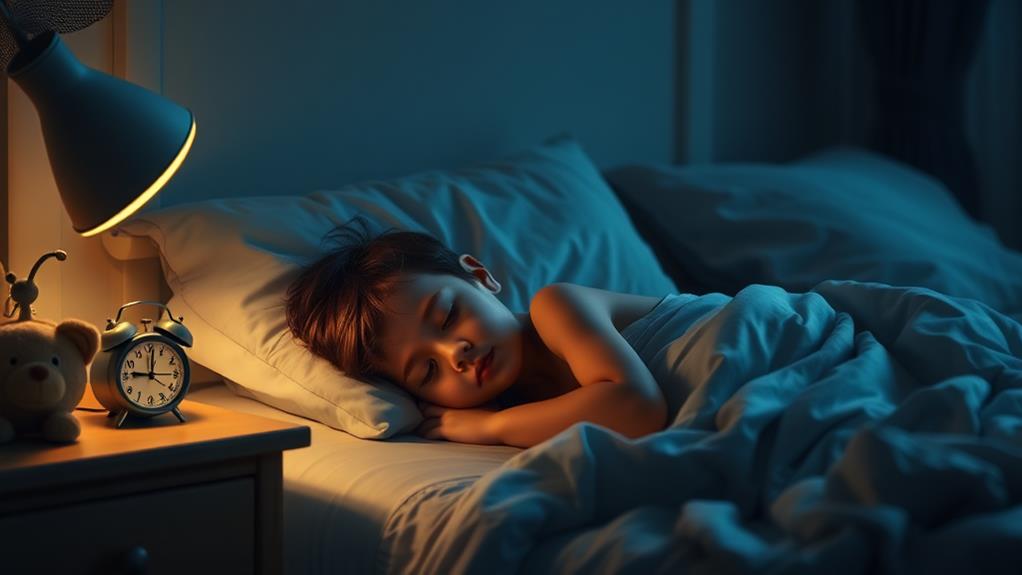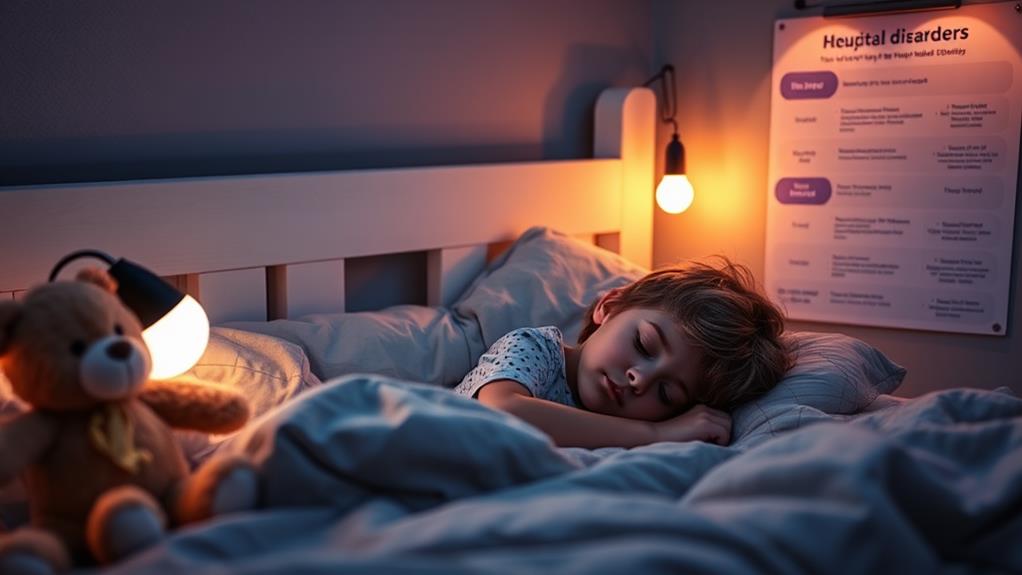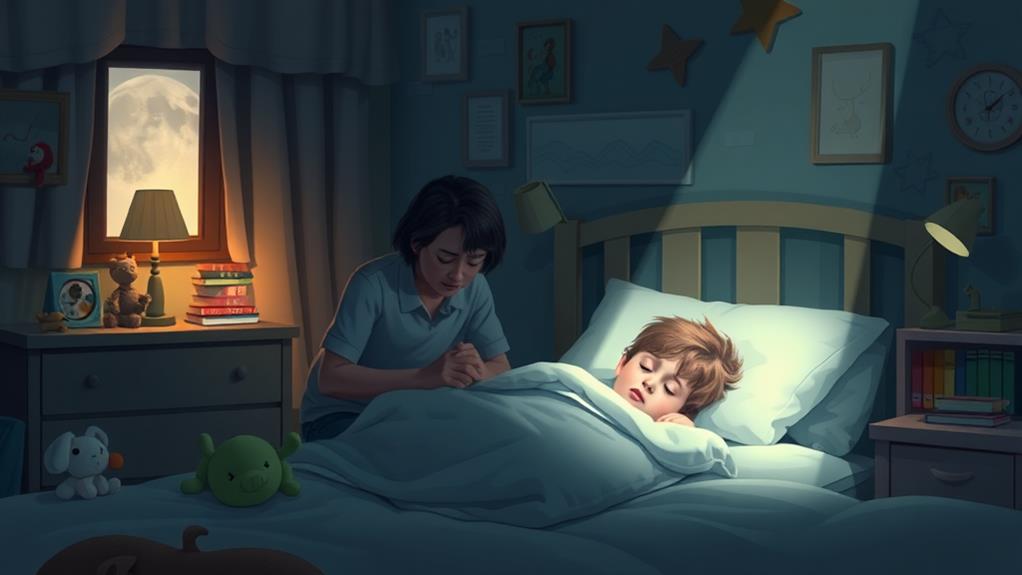As a parent, you might notice your child struggling with sleep more often than you'd like. It's not just about occasional restlessness; sleep disorders like insomnia, sleep apnea, and restless legs syndrome can significantly impact their well-being. Recognizing the symptoms and understanding the underlying causes are crucial steps in addressing these issues. So, how do you know when to intervene and what strategies can actually help? Exploring the signs and effective solutions might just lead you to better nights—and happier days for your child.
Common Sleep Disorders

When it comes to kids, sleep disorders can significantly impact their daily lives. Understanding the common types of sleep disorders helps you identify any issues your child might face.
One of the most prevalent disorders is insomnia, where kids struggle to fall asleep or stay asleep. This can lead to crankiness and difficulties in concentrating at school.
Another common issue is sleep apnea, characterized by pauses in breathing during sleep. This can leave your child feeling tired even after a full night's rest.
Night terrors, which can cause intense fear and confusion during sleep, are also something many kids experience. These episodes can be alarming but are usually harmless.
Then there's restless legs syndrome, where children feel uncomfortable sensations in their legs, making it tough for them to relax and fall asleep.
Lastly, narcolepsy is a rare but serious disorder that causes sudden sleep attacks during the day.
Symptoms to Watch For
As a parent, it's crucial to be aware of the symptoms that may indicate your child is struggling with a sleep disorder. If your child often has trouble falling asleep or staying asleep, it could be a sign something's off.
Look for signs like frequent nightmares or night terrors, which can disrupt their rest and leave them feeling anxious. You might also notice excessive daytime sleepiness, where they struggle to stay awake during class or while playing.
Another symptom to watch for is snoring or gasping for air during sleep, which could indicate a condition like sleep apnea. If your child seems irritable or has mood swings, it could be linked to poor sleep quality.
Keep an eye on their behavior as well; hyperactivity or difficulty concentrating can also point to sleep issues.
If you notice these symptoms persisting over time, don't hesitate to consult a healthcare professional. Early intervention can make a big difference in helping your child get the restful sleep they need for healthy growth and development.
Causes of Sleep Disorders

Sleep disorders in kids can stem from various causes that often require careful consideration. One common factor is anxiety, which can make it tough for your child to relax and drift off to sleep. Stressful situations, like school pressure or family changes, can also contribute to restless nights.
Another cause could be environmental factors. Things like noise, uncomfortable bedding, or too much screen time before bed can disrupt their sleep pattern. Additionally, certain medical conditions, such as asthma or allergies, might also interfere with their ability to sleep well.
You shouldn't overlook lifestyle choices, either. Irregular sleep schedules or consuming caffeine too late in the day can throw off their internal clock. Even sleep disorders like sleep apnea, which can affect breathing, may be at play.
Lastly, genetics might play a role; if sleep issues run in your family, your child could be more likely to experience them as well.
Diagnosis and Evaluation
Understanding the causes of sleep disorders in kids is just the first step; diagnosing these issues requires careful evaluation. You might notice your child having trouble falling asleep, waking up frequently, or snoring loudly. When these symptoms arise, it's important to consult a pediatrician or a sleep specialist.
They'll usually start by asking detailed questions about your child's sleep patterns, daily habits, and any stressful events that might contribute to their sleep issues. To gain a clearer picture, they may recommend a sleep diary. This diary can help track your child's sleep schedule, nighttime awakenings, and daytime behavior.
Sometimes, your doctor might suggest a sleep study, called polysomnography, where your child stays overnight in a sleep lab. This study records brain waves, heart rate, and breathing patterns, providing valuable insights.
Additionally, keep an eye out for underlying medical problems, like allergies or asthma, which can disrupt sleep. By working closely with healthcare professionals, you can ensure that your child gets the help they need.
Treatment Options Available

When it comes to treating sleep disorders in kids, a variety of options are available that can significantly improve their rest and overall well-being.
First and foremost, behavioral therapies are popular choices. These approaches often involve helping your child establish a consistent bedtime routine, which can make a big difference in their sleep patterns.
In some cases, healthcare professionals may recommend cognitive behavioral therapy (CBT). This can help address any negative thoughts or fears surrounding sleep.
If the sleep disorder is more severe, medication might be an option. Always consult with a pediatrician before considering this route, as they can guide you through the process and monitor any side effects.
Another effective treatment is addressing any underlying medical conditions. For example, if your child has allergies or asthma, treating these issues could improve their sleep quality.
Additionally, sleep clinics often offer specialized programs tailored to your child's specific needs, ensuring they receive the best care.
Lastly, encouraging open communication with your child about their sleep experiences can help you identify potential triggers and solutions.
Tips for Better Sleep
Improving your child's sleep doesn't have to be complicated. Start by creating a consistent bedtime routine. Kids thrive on predictability, so having the same activities each night—like reading a story or taking a warm bath—can signal that it's time to wind down.
Next, make their sleep environment cozy and comfortable. Keep the room dark, cool, and quiet. Consider using blackout curtains and a white noise machine to block out distractions.
Limit screen time before bed, as the blue light from devices can interfere with their ability to fall asleep. Aim for at least an hour of tech-free time before bedtime. Instead, encourage calming activities like drawing or talking about their day.
Also, watch their diet; avoid heavy meals and sugary snacks close to bedtime. Instead, offer a light snack if they're hungry, like a piece of fruit or yogurt.
Lastly, ensure your child gets regular physical activity during the day. Exercise can help them feel more tired and ready for sleep by nighttime.
With these simple tips, you can help your child develop healthy sleep habits that will last a lifetime.
When to Seek Help

Sometimes, parents may feel uncertain about whether their child's sleep issues warrant professional help.
It's crucial to recognize that not all sleep problems are the same. If your child frequently struggles to fall asleep, wakes up multiple times during the night, or experiences nightmares that disrupt their rest, these could be signs that something more serious is at play.
You should also consider the impact on their daily life. Are they excessively sleepy during the day? Is their mood affected, or are they having trouble concentrating at school?
These issues can indicate that it's time to seek help. Consulting a healthcare professional can provide clarity and direction.
Don't hesitate to reach out if your child's sleep troubles persist for several weeks, despite trying various sleep strategies. A pediatrician or sleep specialist can assess your child's specific situation and recommend appropriate treatments or interventions.
